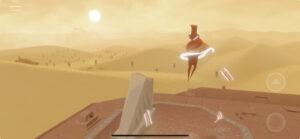

For my critical play, I played the game “Journey,” which is targeted towards anyone 4+ years or older. I installed it on my iPhone, one of its main platforms, but it is also available on PlayStation and PC. It was developed by Thatgamecompany, a gaming studio created by USC students in 2006.
When you first install the game, you are given no instructions. The developers really leaned into the theme of discovery, baking it into everything the second you open the app. You seem to know no more about where you are or the world around you than the character you control. Through walking, the game takes advantage of this lack of information to push the you towards a journey of environmental discovery that helps you piece together the story of the game world, and embark on your own adventures.
When you first start the game, the first thing you notice is its minimalistic design. On top of that, you also notice that the developers intentionally avoid the traditional heads-up display and lean into audio and visuals, using these cues to guide players through the game world. The vibrant artistic style creates a sense of wonder and the the soundtrack perfectly complements it. This focused minimalism makes it incredibly easy to immerse one’s self in the game and focus on the journey itself rather than on extraneous information that causes distraction. This is notably different than games such as “Firewatch” that rely on more direct narrative techniques, like as dialogue or written notes to tell their story. In Journey, the story isn’t told, it is discovered. There is an inherent trust that the player can piece together the narrative through their own exploration and interpretations.
The game’s mechanics, such the simple controls and interaction with the environment encourage you to focus on the game environment. My first reaction to this was “Oh this is all you can do?”, but that sentiment quickly faded into the background as all my attention turned towards exploration.
Player relationships are also incredibly interesting here. At the beginning, you spend most of your time alone, just walking around, and it gets pretty isolating. I was honestly really confused here, and I really wished I can play this with other people. This quickly turned into excitement, however, when I ran into other players and realized that this is a possibility. And, given the previously explained context, this built interesting dynamics that foster a sense of companionship and shared experience, without even needing direct communication like in other games.
Near the end of the journey, the player that walked the entire way to the mountain with no shortcuts, gains the ability to fly, in what can be seen as a beautiful transformation. After feeling trapped and isolated at the beginning of the game, I saw flying as representing a newfound sense of freedom and transcendence. Its as if you break free from the limitations of earthly existence and soar towards a higher plane of understanding. It is a semblance of the human experience, where we all strive to overcome obstacles, grow as individuals, and ultimately find meaning. And, in an artistically beautiful way, “Journey” weaves this narrative into its gameplay. Here the game’s purpose extends beyond just entertainment; its an invitation to reflect on one’s your personal journey and universal themes of connection, perseverance, and self-discovery. Its honestly a beautiful space, and the choice of walking was incredibly fitting for the storytelling.



